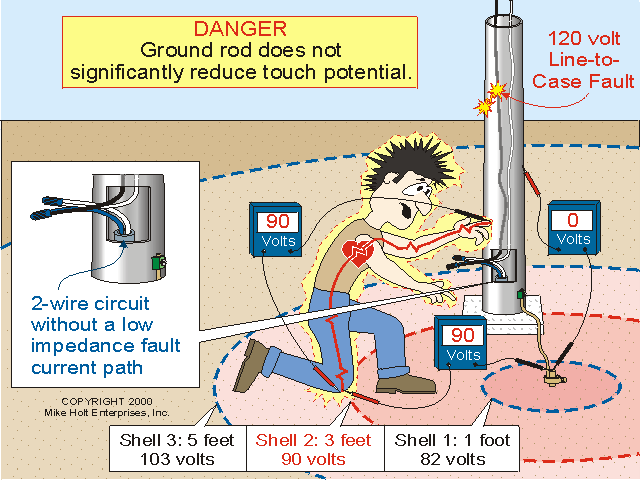090531-2325 EST
hurk27:
With respect to your comments in post #34.
Voltage measurements are always relative to some reference point. In my experiment of one 8 ft rod and long water pipe I can use any desired point for my measurement reference. I used the water pipe because I was interested in the voltage gradient relative to it. I could have used the 8 ft rod as the reference, or some place in the middle of the backyard, or somewhere half a mile away. The later creates problems if there are other current or voltage sources. This is one reason I did a residual voltage measurement in the yard with no current injected into the 8 ft rod.
The water pipe is bonded to the return path for the 120 volt source you connected to the rod, yes you could have reference the voltage between two isolated points but, this would only show the voltage across these two points and not the true voltage of a energized point and Earth at a given distance from this energized point. this type of measurement would be mute as one could not contact these two points as they would two far apart, unless there was a conductive pathway to this point, which would still reference the energized voltage to earth. the voltages you measured at 3' from the rod to the water pipe only reflect the voltage drop from the rod, in this case 120 volts minus 30.2 volts would equal a 69.8 voltage potential at the 3' mark, from the rod, still a dangerous shock hazard. next lets say a person was to contact a conductive path such as the metal siding of the afore mention trailer at a distance of 5' from this rod, the voltage would be much higher somewhere around 100 volts for your rod which is some what lower in Resistance that the average conductivity of earth. this will only go higher as a person moves out from the rod.
090531-2325 ESTThe results of the experiment do not change if I go into the middle of an isolated field somewhere with no currents other than those I create. Whether I connect the center tap of the transformer to the 8 ft rod or to the water pipe makes no difference in the voltage gradient from the rod to the pipe.
Same answer as above
Some values of resistivity are given at:
http://wiki.myelectrical.com/index.php?title=Earth_Resistivity
A measurement method is also described.
In your reference to the SWER system there are some parameters referenced like current and voltage gradient. 10 A ball park and 20 V/M. This is before you make any effort to shield a given area.
090531-2325 EST Suppose you cover the earth with a copper sheet in the area you want protected and connect this to your neutral, then anything on top of this sheet will be very close the voltage at your transformer neutral even with 10 A flowing under the sheet and some of it Thur the sheet. This does not address what happens as you exit the conductive sheet.
This is an equal potential ground plane, and yes this is a true statement, But a ground rod or a horizontal pipe or even a ring electrode will not create this, just because like it said in the link you provided 67% of the resistance is in the first .3 meters from the electrode, this would mean that the ground ring would have to be smaller then .3 meters in diameter to form a equal potential plane within the ring, too small to be of use. and then if it is buried at the 24" normally required it would not protect a person standing on top of it. this is because of the spherical of influence is all encompassing of the ground ring conductor at the same distance from it as mention in the web site you posted.
090531-2325 ESTNow add to the surface sheet some vertical sheets into the earth and connected to the surface sheet. This will reduce the current flowing under and up into the bottom side of the surface sheet.
again this would act just as above
090531-2325 ESTNow Next put a bottom sheet in the earth and remove the surface sheet. All the earth inside this 5 sided box will will be at the potential of the sides of the box. The box is highly conductive compared to the earth. Thus, current flowing Thur the earth outside the box will flow in the conductive box but extremely little Thur the earth inside the box.
again same as above
090531-2325 ESTNow Using suitable dimensions you can start putting holes in the conductive sheets and have little change in the equal potential earth in side the box. Then the sheets can be turned into rods.
same as above, just like the "hole between the wire mesh used in equal potential ground planes. but if the holes were larger then a given size, again there would be a potential if a person could stand in the middle of one of these holes and touch the energized ground plane. .3 meters is not very big.
I wish I had some graphic program on this puter to show like in Mike Holt example, of how the sphere of influence looks like and how it will go right passed other metal objects in its sphere. in the case of a vertical rod if you imagine a set of equally smaller bowls placed in the Earth with the top level with the Earth and filled with earth then place the rod in the middle of the smallest bowl, you would have the same image that in in the previous post but with the image of what it looks like underground. with other electrodes that are buried below earth this sphere takes a more ball shape elongated to the shape of the electrode. and in a ring it would be like a big donut.


